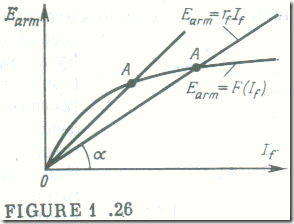The Process of Self-Excitation
In most d.c. generators the field current is part of the armature current. At starting there is no current in the armature and, as a consequence, in the field winding, but the substantial frame always retains some residual magnetic flux Φr amounting to 1-3% of the normal operating magnetic flux of the machine. When a prime mover begins to rotate the armature, the residual flux induces a small emf in the armature winding. In a shunt generator this emf, Earm oc , gives rise to a current, if, in the field winding, and there appears an excitation mmf. It may act aiding or in opposition with respect to the residual magnetic flux if , that is, it may magnetize or demagnetize the magnetic circuit of the machine. For self-excitation to take place, it may act aiding, and this requirement is flux Φr , by properly connecting the field winding to the armature winding. With such a connection, the field set up by the excitation current will augment the magnetic field of the machine, and the resultant field will induce a large emf in the armature winding. The increase in armature emf leads to a further increase, or build-up, of excitation current. This spontaneous build-up of flux and current is limited by the saturation of the magnetic circuit of the machine.
After the transient build-up process is completed, the armature emf, Earm , and the field current, If , take on their steady-state values. They can be found by reference to the open-circuit characteristic of the machine (Fig. 1.26). If we neglect the resistance of the armature circuit, rarm , in comparison with that of the field circuit , rf the steady-state field current If will be such that Earm = rfIf . This equality corresponds to the intersection of the open-circuit characteristic Earm (If) and the straight line Earm = rfIf line , defined as the tangent of the angle a , depends on rf , If we reduce If by, say, bringing the field rheostat in the field circuit, the balancing point will shift to the left (A‘). When the resistance of the field circuit is at its critical value, the machine will not build up at all.
If no residual magnetization has remained in a machine (because its armature winding has been shorted or the machine itself was jarred), it can be restored by connecting an external d.c. source to the field winding of the demagnetized machine for a short time (so as to "flash the field" of the machine). Once restored, the residual magnetic flux can be used for normal self-excitation.
Self-excitation is used in shunt and compound generators.

